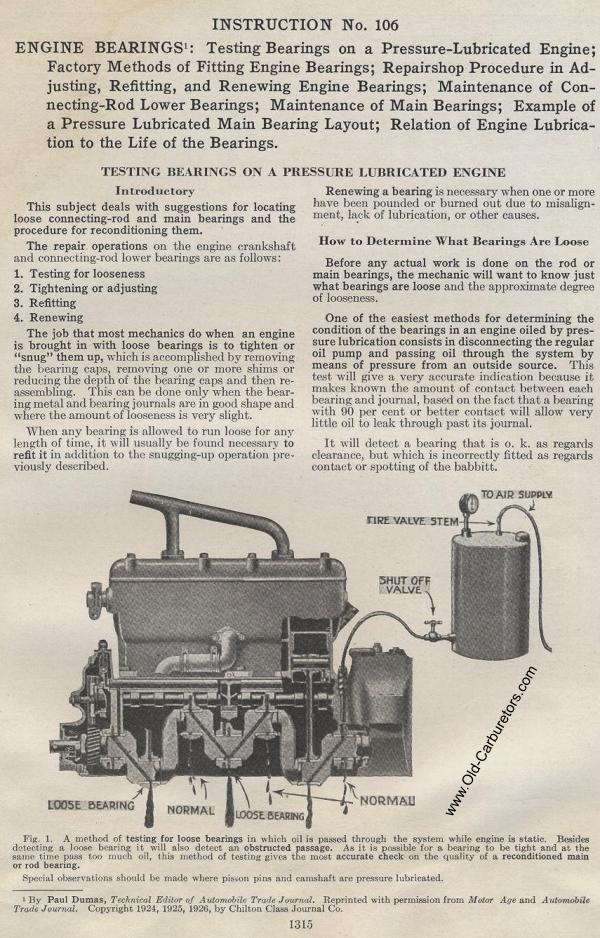ENGINE BEARINGS:
Testing Bearings on a Pressure-Lubricated Engine;
Factory Methods of Fitting Engine Bearings; Repairshop Procedure
in Adjusting, Refitting, and Renewing Engine Bearings; Maintenance
of Connecting-Rod Lower Bearings; Maintenance of Main Bearings;
Example of a Pressure Lubricated Main Bearing Layout; Relation
of Engine Lubrication to the Life of the Bearings.
TESTING BEARINGS ON A PRESSURE LUBRICATED ENGINE
Introductory
This subject deals with suggestions for locating loose connecting-rod
and main bearings and the procedure for reconditioning them.
The repair operations on the engine crankshaft and connecting-rod
lower bearings are as follows:
1. Testing for looseness
2. Tightening or adjusting
3. Refitting
4. Renewing
The job that most mechanics do when an engine is brought in with
loose bearings is to tighten or "snug" them up, which
is accomplished by removing the bearing caps, removing one or more
shims or reducing the depth of the bearing caps and then re-assembling.
This can be done only when the bearing metal and bearing journals
are in good shape and where the amount of looseness is very slight.
When any hearing is allowed to run loose for any length of time,
it will usually be found necessary to refit it in addition to the
snugging-up operation previously described.
Renewing a bearing is necessary when one or more have been pounded
or burned out due to misalignment, lack of lubrication, or other
causes.
How to Determine What Bearings Are Loose
Before any actual work is done on the rod or main bearings, the
mechanic will want to know just what bearings are loose and the
approximate degree of looseness.
One of the easiest methods for determining the condition of the
bearings in an engine oiled by pressure lubrication consists in
disconnecting the regular oil pump and passing oil through the
system by means of pressure from an outside source. This test will
give a very accurate indication because it makes known the amount
of contact between each bearing and journal, based on the fact
that a bearing with 90 per cent or better contact will allow very
little oil to leak through past its journal.
It will detect a bearing that is o. k. as regards clearance, but
which is incorrectly fitted as regards contact or spotting of the
babbitt.
Fig. 1. A method of testing for loose bearings in which oil is
passed through the system while engine is static. Besides detecting
a loose bearing it will also detect an obstructed passage. As it
is possible for a bearing to be tight and at the same time pass
too much oil, this method of testing gives the most accurate check
on the quality of a reconditioned main or rod bearing.
Special observations should be made where piseon pins and camshaft
are pressure lubricated.
i By Paul Dumas, Technical Editor of Automobile Trade Journal.
Reprinted with permission from Motor Age and Automobile Trade Journal.
Previous page 1927
Supplement Home Next page 
|
